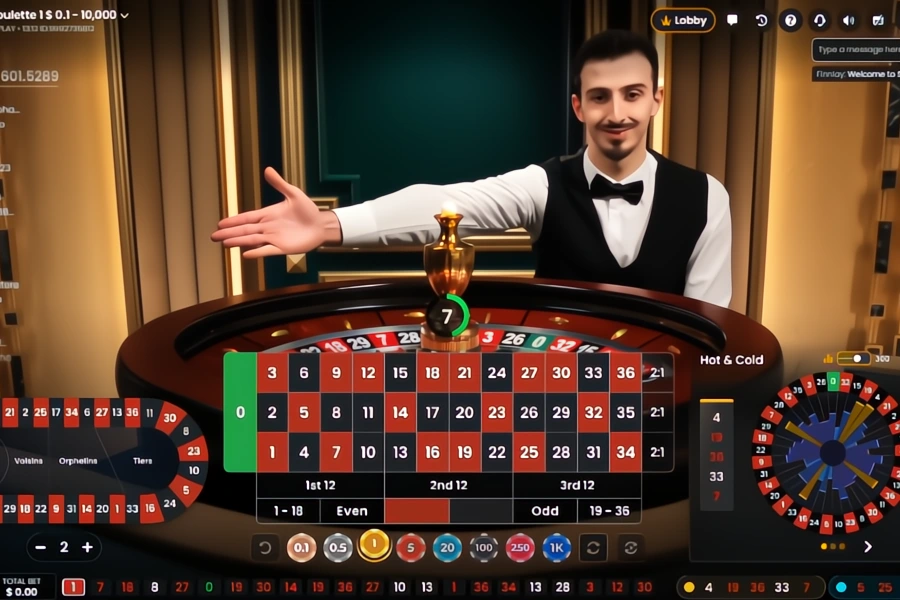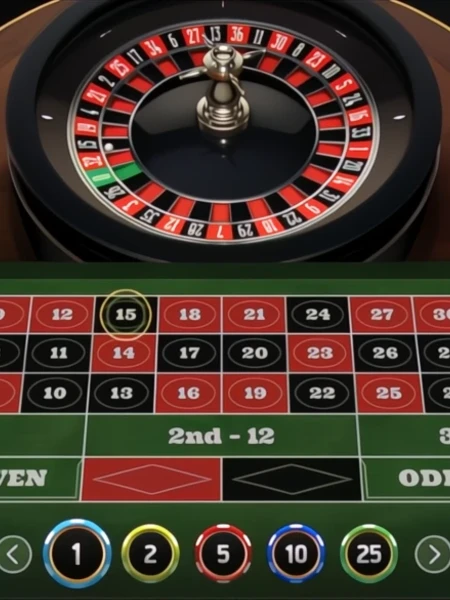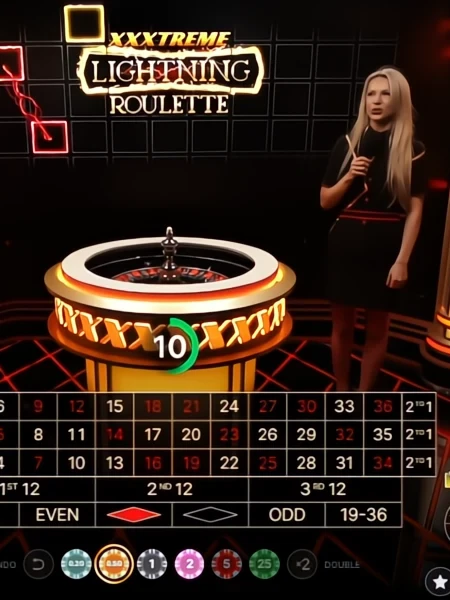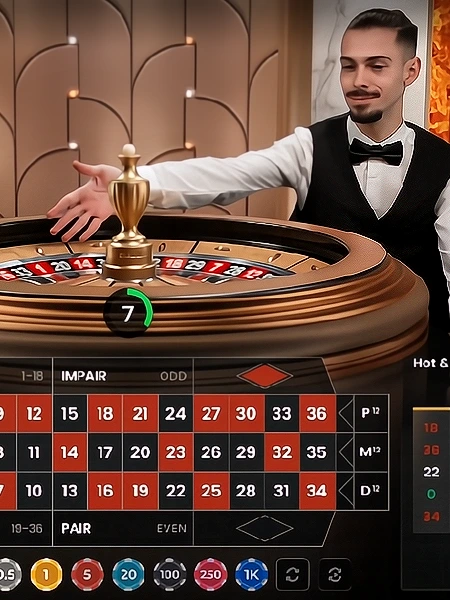Last Updated: 29 September 2025
Winning Roulette Strategies That Actually Work: From Martingale to James Bond
Are you ready to start crushing roulette games? To do so, you need the right strategy, and we have just what you are looking for. From the Martingale and D’Alembert to the James Bond bet, we will introduce you to the best roulette strategy options that actually work in the real world.
Uncategorized
How Roulette Works: Know the Wheel Before You Bet
The roulette wheel is divided into sections, each marked with a number and a corresponding color. Numbers between 1 and 36 are marked with either red or black color, while the 0 and 00 slots are marked with green color.
Before every roulette spin, you get to place a variety of bets. These range from outright bets, which pay 35:1, to even money bets like black/red and odd/even. You can bet on a single number, or multiple numbers at once, by placing your bets on the edges between the numbers on the roulette betting table.
Once all the bets are placed, the dealer spins the ball on the roulette wheel and announces “no more bets.” The ball then spins until it lands in one of the slots on the wheel. If you made bets that include the winning number, you get paid out in accordance with the roulette paytable.

What Are the Two Types of Roulette Betting Strategies
While there are many different roulette betting strategies, they can be broadly categorized into two main types: progressive betting systems and flat betting systems. These two basic betting principles guide roulette players, with each strategy applying nuance to the general idea.
Progressive Betting System
Roulette strategies with progressive betting involve increasing your bet at various points. Different strategies recommend increasing your bet following a losing spin, a winning spin, or for a number of consecutive spins, regardless of results. Progressive betting systems may require a substantial bankroll to execute correctly, as you may have to double up your bet multiple times. Table betting limits can also get in the way, which is why it’s important to apply progressive betting strategies on tables that allow for a wide range of bets.
Flat Betting System
Unlike progressive betting systems, flat betting systems advise maintaining a consistent betting pattern. Flat betting allows you to play at a steady pace and not be too affected by longer losing streaks. These types of betting strategies are ideal for players who are not looking to take huge risks, but rather enjoy playing for a longer time and with minimal variance. Flat betting does not take full advantage of winning streaks, but also reduces the risk of massive losses during losing ones.
7 Timeless Roulette Strategies Every Player Should Know
Now that you have the general idea of how roulette strategies work, let’s get into the nitty-gritty and explore the most popular roulette strategies out there.
You can test each of these strategies at the CoinPoker roulette tables, which offer affordable minimal stakes and allow you to practice the strategies at your own pace.
| Strategy Name | Core Idea | Risk Level | Best For |
| The Martingale | Double your bet after a losing spin | High | Short sessions, big bankroll |
| Grand Martingale | Double your bet + add an initial bet after a losing spin | Very High | Short sessions, huge bankroll |
| Paroli | Keep betting your wins until you reach a preset goal | Medium | Longer sessions, medium bankroll |
| Fibonacci | Use the Fibonacci numbers sequence to guide your bets | Medium | Long sessions, limited bankroll |
| D’Alembert | Gradually up your bets after losses, decrease them after wins | Medium | Long sessions, limited bankroll |
| Labouchere | Use a cancellations system to reach a preset goal | Medium | Short sessions, limited bankroll |
| The James Bond Bet | Bet on a large portion of the roulette wheel in search for steady wins | Low | Long sessions, limited bankroll |
Next, we’ll explain each of these seven roulette strategies in detail:
The Martingale
The Martingale is one of the most famous roulette betting strategies, built around the idea of doubling your bet after every losing spin. To be successful with the Martingale, simply pick a side in an even-money bet, such as red or black. If you lose, simply double the bet and spin again. Keep doubling the bet until you win, at which point you will show a profit.
For example, start by betting $5 on red. If the winning number is black, bet $10 on red on the next spin. If the winning number is black again, simply bet $20 on red the next spin. If you win this time, you will have won $40, which covers all of your bets and gives you a $5 profit.
The Martingale betting strategy is great for short roulette sessions, but it does require a hefty bankroll. It is also worth noting that table limits can make the strategy ineffective, while longer losing streaks can make the risk-to-reward ratio unreasonable.
Grand Martingale
The Grand Martingale is a slightly more aggressive version of the classic Martingale, which also promises bigger profits when successful. The idea is quite similar, but the execution is slightly different. Instead of simply doubling your bet every time you lose, the Grand Martingale also adds a base unit on top of the total bet.
For example, imagine starting with a bet of $10 on even. If this bet loses, you would not only double the bet to $20, but also add a base bet of $10 on top, for a total of $30. If this bet loses again, you would double the $30 and add $10 on top, for a total bet of $70. Continue doing this until you win, and then go back to your initial $10 bet.
The Grand Martingale is a more risky version of the traditional betting system, but one that also offers greater rewards for players with substantial bankrolls and a high level of confidence.
Paroli
Opposite to the Martingale, the Paroli betting system is a positive progression strategy. When practicing Paroli, you will be increasing your bets after every win, looking to capitalize on hot winning streaks. How far you go with Paroli is up to you, which makes this strategy very open-ended.
For example, imagine starting with a bet of $10 on the black number. If your bet wins, you bet the total $20 you just won on black again. If you win again, bet $40 on black. If you win again, you now have $80, for a $70 profit from your starting $10 stake. You can choose to cash out at any time, although most players apply the Paroli strategy in steps of 3, before reverting to the base bet.
The Paroli strategy is ideal for more cautious players who prefer to control their risks and capitalize on their lucky streaks, rather than pushing their luck.
Fibonacci
Based on the famous Fibonacci number sequence, the Fibonacci roulette strategy is another popular progressive betting system. The sequence is made up of a set of numbers, where each number represents the sum of the two preceding it (1, 1, 2, 3, 5, 8, 13…). With the Fibonacci strategy, you go up one step after each loss, and down two steps after each win. The base bet is multiplied by the numbers in the sequence to determine the size of the next bet.
For example, imagine you start by betting $10 on odd numbers on your first spin. If you lose, you move to the next number in the sequence, which means your bet remains $10. If you lose again, you go up the sequence, multiplying your base, and betting $20, $30, $50, $80, etc. If you win with an $80 bet, move down two spots, which means your next bet is $30. Continue the sequence until it feels right, or until you have met your goal for the session.
The Fibonacci strategy is perfect for players with a more methodical approach to roulette, who enjoy a steady pace of play.
D’Alembert
Invented by French mathematician Jean le Rond d’Alembert, the D’Alembert strategy is another very popular progressive betting system. The D’Alembert is similar to both Martingale and Fibonacci betting strategies, although the betting sequence is a bit different. Instead of doubling your bets or following the Fibonacci sequence, you go up one unit every time you lose, and down one unit every time you win.
For example, imagine you start with a $20 bet on red. If the ball lands in black, you go up to $40 on the next spin. If you lose again, bet $60 on the next spin. If you win this time, return to $40. Going up and down the ladder this way allows you to capitalize on winning streaks while limiting your losses during losing ones.
The D’Alambert is a less volatile version of the Martingale, making it perfect for more risk-averse players and those with more limited bankrolls.
Labouchere System
The Labouchere strategy is often referred to as the Cancellation System, and it is one of the more intricate roulette strategies. This structured strategy allows you to set a profit goal at the start, and keep playing the sequence until you cancel all the numbers, at which point you have reached your goal. The numbers in the sequence should add up to the multiplier you are aiming for. For example, if you want to win $100 from a base unit of $10, your sequence should add up to 10.
If your goal is to win 10x your money, your starting sequence should be 1-2-3-4. To start, choose your base unit (for example $10), and add the first and last numbers together to determine the amount you should bet. In this case, the amount is $50. If you win, cancel out the two numbers, which just leaves the 2 and 3 in the sequence. If you lose, add the number to the end of the sequence, making it 1-2-3-4-5 for the next spin. Keep adding the first and last number together and betting the appropriate amounts until all numbers are cancelled out, and you have won your designated amount.
The Labouchere is a complex strategy that enables you to work towards a predetermined goal. Keep in mind that it’s somewhat easy to make a mistake in calculations with this one, so be careful and keep close track of your sequence.
The James Bond Bet
Made popular by the famous fictional spy, the James Bond bet is one of the most entertaining flat betting systems in roulette. The betting pattern is quite simple. Your bet should cover two thirds of the table, with 70% of the bet going to all numbers higher than 18, 25% of the bet going on numbers 13 to 18, and 5% of the bet going on 0. This strategy works well on European and French roulette wheels, which have the lowest house edge.
For example, if your starting bet is $100, you should bet exactly $70 on numbers from 19 to 36, $25 on numbers from 13 to 18, and $5 on 0. If the ball lands in one of the big numbers, you profit $40. If it lands in a number from 13 to 18, you profit $50. Finally, if you hit 0, you profit $80 for the spin. The only times you lose with James Bond is when the ball lands in a low number, from 1 to 12.
The James Bond strategy is ideal for short sessions and a low-risk approach, but can be a bit limiting for long-term play.
Betting Systems for Different Roulette Game Variants
Online casinos offer a variety of roulette wheels you can try, ranging from classic European and American roulettes to novelty games like Lightning Roulette. Whether you opt for one of the virtual wheels or a live roulette game, we recommend adjusting your strategy to the exact wheel you are playing.
Here are some tips on the best strategic approach for different popular variations of the game.
European Roulette Strategy
European Roulette is generally considered to be one of the more player-friendly roulette wheels, with a house edge of just 2.7%. The high payout percentage makes the game compatible with betting strategies like the Martingale and Fibonacci. If you are looking to play longer sessions, flat betting can also work quite well, with the James Bond bet typically proving more successful at European than American Roulette wheels.

American Roulette Strategy
The increased house edge of American Roulette makes the game a bit less favorable to play than its European counterpart. If you do end up having to play American Roulette, however, consider betting strategies that minimize risk. Betting patterns like D’Alembert and Fibonacci, which are less risky than the Martingale, are recommended. You may also opt to go with flat betting and chasing your favorite numbers until they land. However, the best American Roulette strategy we can offer is to look for a European Roulette wheel instead.

Lightning Roulette Strategy
Lightning Roulette is a unique roulette game that offers payouts as high as 500x in its basic version, and even 2,000x in the Xxxtreme version. Flat betting is highly recommended in Lightning Roulette, as your only big payouts come from hitting those lucky numbers. Regular payouts are minimized to just 29:1 for straight bets, which is why making smaller bets and playing with a more conservative bankroll approach is the smart approach.

Electronic Roulette Strategy
Electronic Roulette games typically follow the same payout patterns as live games, depending on the wheel in question. As you start up an Electronic Roulette game, check the wheel first, and determine if the game is based on the European or American Roulette rules. Apply strategies that work well for the version in question, and the electronic nature of the game should not affect you too much.

Roulette Game Shows Strategy
The novelty roulette game shows introduced by companies like Evolution and Pragmatic Play have taken roulette to new levels. Each game is different, with special multipliers, mini games, and other features introduced. As you approach these new roulette games, we recommend starting with very small bets until you get comfortable with the game. What seems right at first may not be the best approach to the game in question. Experiment with betting patterns and stay cautious until you know what really works.

Roulette Betting Tips to Win More at CoinPoker
The basic roulette betting strategy is simple, and the betting patterns we introduced in earlier sections may help you win more often. However, some other useful tips may help improve your roulette results if applied correctly.
Here are a few tips our experts recommend keeping in mind the next time you play roulette:
Bankroll management is extremely important in roulette. The game can be very volatile at times, and even more so if you choose to apply a progressive betting pattern. As a roulette player, you should always be careful with your bankroll and ensure you have the necessary funds to sustain at least an average losing streak. Smart players adopt an even more conservative approach, ensuring they can continue playing even when luck truly turns its back on them.
Tracking game history can be helpful when deciding which bets to place. For example, if you are looking to play the Martingale betting system, check the roulette history. If the last four numbers were all red, starting with a bet on black may be wise. If you are thinking of a James Bond bet, check how many small numbers landed recently, and see if you can avoid them on the next spin.
Roulette is one of the best gambling games in any casino, but it’s not the only option. Other games, such as slots, can often provide the same amount of excitement with fewer swings. Modern casino games, such as crash games, often come with the highest RTP rates and the lowest house edge you can imagine, making them your best bet if you are looking for optimal value.
Setting a clear goal before every roulette session is a good idea. This is especially true with betting strategies like Paroli, Labouchere, and Fibonacci, which theoretically allow you to keep increasing your bets indefinitely during winning streaks. For example, you may decide to start with a $10 base bet and play until you win $100. This way, you will know exactly when to quit, and won’t be tempted into riding the winning streak indefinitely, which ends badly more often than not.
Common Roulette Myths and Mistakes
Roulette is a game shrouded in mystery, with numerous myths surrounding it. As you start playing, we recommend avoiding these common roulette mistakes:
- Playing the Wrong Game: If you can help it, avoid playing American Roulette and opt for European or French Roulette wheels instead.
- Chasing Losses: Sometimes, the odds are not in your favor. Don’t chase your losses beyond your predetermined budget.
- Playing Too Long: Whether you are winning or losing, playing roulette for too long is likely to end in a disaster. Limit your playing time and come back to play another day.
- Betting Too High: If you ignore bankroll management and play beyond your means, your likelihood of success is very low.
- Thinking Strategy Is Certainty: No roulette strategy can guarantee success. Whether you apply the Martingale or the James Bond bet, there are no certain wins in roulette!
Test Your Roulette Betting Systems at CoinPoker Today

Now that you have learned the basic roulette betting strategies, it’s time to try them in a real casino setting.
Join CoinPoker right now, claim your casino bonus, and put your preferred roulette strategy to the test.
Our real money roulette tables are waiting, offering the lowest stakes possible for you to practice your strategy and perfect your betting patterns.
Play Responsibly
As you start playing real money roulette at CoinPoker, we urge you to stay responsible with your betting. Play within your means, and never risk funds you cannot afford. If you need help with this, check out our responsible gambling page and use our RG tools like reality checks and self-exclusion to help you. For further help, look to organizations like the National Council on Problem Gambling or Gamblers Anonymous.
FAQs
Beginners should focus on flat betting strategies, with the James Bond bet offering a low-risk approach that makes sense for novices.
All roulette strategies come with a dose of risk, but flat betting systems and progressive betting strategies, such as D’Alembert, may help reduce game volatility.
Yes, you can! Just make sure you are aware of table limits before you start, and adjust your starting bet accordingly.
Yes! European Roulette has an RTP of approximately 97.3%, while American Roulette has an RTP of approximately 94.6%, making European Roulette a more favorable option for the player.
All roulette betting strategies are perfectly legal to use in both online and live casinos.
Roulette betting systems may help you win for a while, but none of them can guarantee a long-term profit in any capacity.
Typically speaking, you will want to use the more risky betting strategies in roulette games with the highest RTP and lowest house edge.
Flat betting systems encourage repeating the same bet over and over, while progressive betting systems recommend doubling or increasing the bet after a losing spin.
Explore More
Announcements
Read recent announcements from CoinPoker about new games, ambassadors, and changes to our platform.
8 PostsGuides
The go-to resource for mastering poker with expert tips and strategies. Whether you're a beginner or a pro, our guides will elevate your skill level.
60 PostsNews
Find the latest poker news from CoinPoker, plus our latest CoinPoker Weekly and Monthly Newsletters. Updates about games, promotions and other exciting crypto news.
90 PostsPromotions
Find the latest coinpoker promotions here. Explore the crypto poker world with the best poker promotions available.
1 Post
















